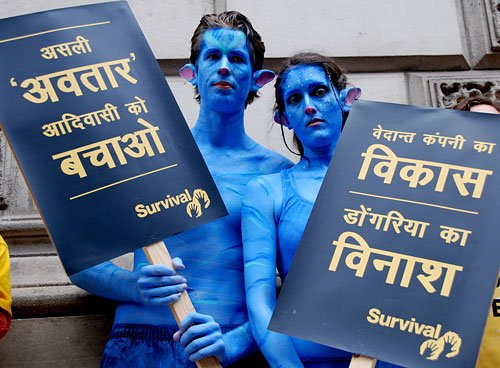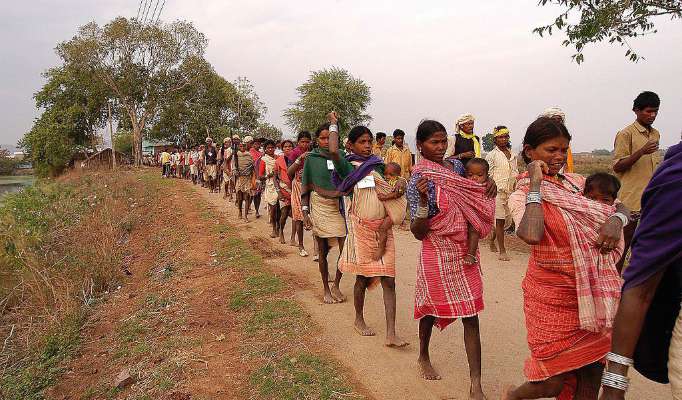Posted by Debanand Naik
On 20th February 2019, the Supreme Court directed all states to evict Scheduled Tribes (ST) and Other Traditional Forest Dwellers (OTFD) whose claims over forest land have been rejected. This article critically analyses the legal perspectives and humanitarian values in the context of this judgment, wherein a Public Interest Litigation (PIL) was filed by the NGO, Wildlife First challenging the Forest Rights Act, 2006.
I recollect news clippings of environmental activists dressed to imitate the Na’avi tribe from Avatar staging a protest in London in support of the tribals of 112 villages of Niyamgiri forest range of southern Odisha who were resisting mining activities by the Vedanta Group of Companies. Amidst massive worldwide protests in support of tribal rights and protection of natural habitats, the landmark verdict of the Supreme Court came on 18th
Though the 2013 verdict of the Supreme Court was in a different context to the current one, the underlying spirit behind it was the recognition of tribal rights and protection of tribal interests while taking a decision on displacing the traditional inhabitants or affecting their natural rights.

It is pertinent to clarify, at the outset, the procedure leading to acceptance/ rejection of claims of STs and OTFDs over forest land. The claims over forest land by the STs and OTFDs are considered by the Gram Sabha (Village Committee). The resolution passed by the Gram Sabha is recommended and forwarded to the sub-divisional level c
After critical examination, the sub-divisional Committee sends its recommendation to the Committee of People’s Representatives. This Committee is tasked with recommending and forwarding the claim to the District Level Committee. The striking part of the Forest Rights Act, 2006 is that the decision of the
Also read: 8 Ways The Avatar Movie Echoes The Struggles Of The Adivasi Community
Let’s focus on two key aspects of the SC ruling. First, while rejecting the claims of the tribals, did the District Level Committee apply it’s rationale
Did the Tribal Claimants, mostly illiterate, get adequate opportunity to understand the requirement of submitting the claim, the process of appeal and ability and resources to defend their claims before the DLC?
As per the provisions under the 2006 Act, after rejecting the claim, the DLC had to send written information to the claimant. Was this requirement was fulfilled? Did the tribal claimants, mostly illiterate, get adequate opportunity to understand the requirement of submitting the claim, the process of appeal and ability and resources to defend their claims before the DLC? An article on IndiaSpends chronicles the story of how 60 tribals in Rawatbhata, Rajashtan, were not even informed of the rejection of their claims. These issues may not have been presented before the Apex Court while fighting for the rights of the tribals.
Second, and most important, the NGO Wildlife First filed this PIL in the interest of protecting and preserving the wildlife of the country. My question is, are the tribals a “danger to wildlife” or they are the real protectors of wildlife? The tribals have been living in various mountain ranges of the country for thousands of years and coexisting with numerous species of wildlife, taking care of each other’s needs.
The tribals have been living in various mountain ranges of the country for thousands of years and coexisting with numerous species of wildlife, taking care of each other’s needs.
How will the tribals’ peaceful habitation be a threat to the free and natural existence of wildlife? Wildlife protection groups might have just taken the easiest and most vulnerable target to find out a solution to their real issue. It is an admitted fact that India’s forest area is relentlessly eroded by human encroachments and animal habitats are shrinking day by day.
Who are these encroachers? Definitely not the limited number of tribals, who have been living in the forests for centuries with limited needs. The problem of deforestation and the threat to natural habitats are the result of insatiable greed of the “civilised society”. Massive mining activities that mercilessly devastate the natural habitats of animals coupled with other natural factors resulting out of global warming is the main villain here.
In non-forest areas also, we do not witness vultures swarming over carcasses, fish and crabs playing in the paddy field with the inundation resulting from the break of first monsoon, crows and sparrows, jackals and wolves roaming at countrysides. These have become amazing stories now. Are the tribals responsible for massive destruction of wildlife and all our natural habitats? The answer is a big no.
Also read: How Inclusive Is India’s ‘Development’ Of Adivasi Communities?
I believe that the case of the tribals need to be viewed more positively and must be presented before the apex court for review with the help of professional and capable counsels.
References
1. The Week
2. Bloomberg Quint
3. GZ
4. Telegraph
Debanand Naik is a Post Graduate in Political Science from Utkal University, Odisha. Presently, he is placed as Asst. General Manager in Punjab National Bank. In addition to his service life, he is associated with various social organisations in the country working on human rights, particularly constitutional rights of SC, ST and OBC people. Reach out to him at dnnaik2011@gmail.com.
Featured Image Source: Pressenza
About the author(s)
Guest Writers are writers who occasionally write on FII.




